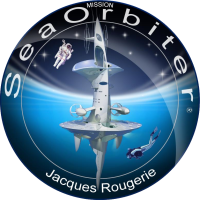SeaOrbiter
 Official Logo of the SeaOrbiter Project
| |
| General characteristics | |
|---|---|
| Type | Research/Semi-submersible |
| Height | 51 m (167 ft) |
The SeaOrbiter, also known as Sea Orbiter (two words), is an ocean going research vessel set for launch in 2013. Similar to a space ship, the SeaOrbiter is planned to allow scientists and others a residential yet mobile research station positioned under the oceans' surface. The station will have laboratories, workshops, living quarters and a pressurized deck to support divers and submarines.[1][2][3]
SeaOrbiter is a project of the "Floating oceanographic laboratory" organisation. It is headed by French architect Jacques Rougerie, oceanographer Jacques Piccard and astronaut Jean-Loup Chretien. The construction of the Oceanographic Laboratory started in 2011. The cost is expected to be around $52.7 million.[4]
Description
The laboratory is semi-submersible ocean going craft and weighs 1000 tons. It has a total height of 51 meters with 31 meters below sea level.
It is designed to float vertically and drift with the ocean currents but has two small propellers allowing it to modify its trajectory and maneuver in confined waters. Underwater robots can be sent from the laboratory to explore the seabed. The hull is made of an alloy comprising aluminum and magnesium is five times thicker than that of a conventional vessel.
Its vertical alignment in the sea will leave a small part visible above the surface with much larger accommodation and laboratories below the sea's surface. Some levels will have a cabin pressure equal to the external water pressure allowing divers to live for extended periods at depth and make frequent excursions.
Visible part
+13.20 M - On top of the "ship", eight antennas, a crane and a lookout with a view of 360 °
+ 6 m / m +5.25 - Below, a first platform contains an elevator, the engine room and a diving center and a decompression chamber treatment,
3 m / +0.5 m - On two floors, the control center includes: aircraft navigation and radio control of the pressurized area, diving trips, the robot; reserve storage.
Submerged part
-2.00m - Quarters for the captain and welcomed guests for short durations, plus a multimedia area,
-4.50m - Observatory and laboratory to analyze and process the data and samples taken. Berths for eight crew members,
-7.00m - Observation room with panoramic dining room and kitchen. Place of relaxation where the crew meets, it is also used for media broadcasts in the main findings.
-9.35m - Chamber for moving from the area at normal pressure in the pressurized area. Submarine hanger with direct access to the sea as well as kitchen, living area and an observation post for eight other crew members.
-11.70m - Berths and work area for eight aquanauts. A platform contains the ballast, water supplies, fuel and is equipped with underwater lights. This is where the aquanauts will train.
A keel of 450 tonnes is under the platform. It is easily releasable in case of problem and retractable to facilitate the crossing of shoals or channels.
See also
- Ben Franklin (PX-15) The brainchild of explorer and inventor Jacques Piccard. The 1968 research vessel was designed to house a six-man crew for up to 30 days of oceanographic study in the depths of the Gulf Stream.
References
- ^ Allen, J.B. (2011). "Nature: Open-Water Investigator". Boys' Life.
{{cite journal}}: Unknown parameter|month=ignored (help) - ^ "SeaOrbiter". SeaOrbiter. Retrieved 22 November 2011.
- ^ "One giant leap for ocean exploration... what the world's first 'space station of the sea' will look like". The Daily Mail. 28 November 2009. Retrieved 22 November 2011.
- ^ Steele, Billy. "SeaOrbiter to begin construction by year's end, project price tag clocks in at $52.7 million". engadget.com. Retrieved 20 June 2012.
See also
- NEEMO, ongoing NASA program
